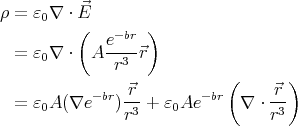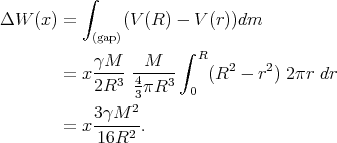 ⊥
⊥ , so
, so  ⋅
⋅ = 0 and
= 0 and  ⋅
⋅ = α. Multiplying the first equation by
= α. Multiplying the first equation by  from the left (using the cross product), we get
from the left (using the cross product), we get  × (
× ( ×
× ) =
) =  ×
× ⇔
a2
⇔
a2 -
- (
( ⋅
⋅ ) =
) =  ×
× . Using that
. Using that  ⋅
⋅ = α,
= α,

-

-

-

(Note: The curl of any radially symmetric vector field is 0.)
-

-

-

The curl of an electrostatic field is 0, so if  and
and  are not parallel, then only
the fields in points (b) and (c) may be electrostatic fields.
are not parallel, then only
the fields in points (b) and (c) may be electrostatic fields.
- The charge density is

Let us calculate the two terms of this sum separately:

where
 =
=  ∕r, and
∕r, and

Thus the complete charge density is

- The total charge enclosed by a spherical surface S of radius r centred
around the origin is

Thus as r →∞, the total charge enclosed by the surface goes to 0.

The sphere has a homogeneous charge distribution, so q =  r3ρ and
dq = 4πρr2dr.
r3ρ and
dq = 4πρr2dr.
Thus the energy needed to assemble a charged sphere of radius R and charge Q is

|
|
The electric field is
 |
and the potential is
 |
Creating a gap by separating the halves is equivalent to removing (“mining out”) all the matter from the gap, and distributing it on the surface (i.e. it causes the same change ΔW in energy). Provided that the gap between the halves is very narrow compared to the planet’s radius (x ≪ R), the change in the gravitational field is negligible.
Using Gauß’s law, it is easily shown that the gravitational potential below the surface of the spherical planet is

where γ is the gravitational constant, M is the mass of the planet, and r is the distance from the centre.
When moving a piece of mass dm up to the surface, the increase in energy is
 V (R) - V (r)
V (R) - V (r) dm. To get the total change in energy, we must integrate
over the volume of the gap:
dm. To get the total change in energy, we must integrate
over the volume of the gap:
 | (1) |
The force keeping the halves together is

(I.e. the same as the weight of an object of mass  M on the surface of the
planetoid.)
M on the surface of the
planetoid.)
